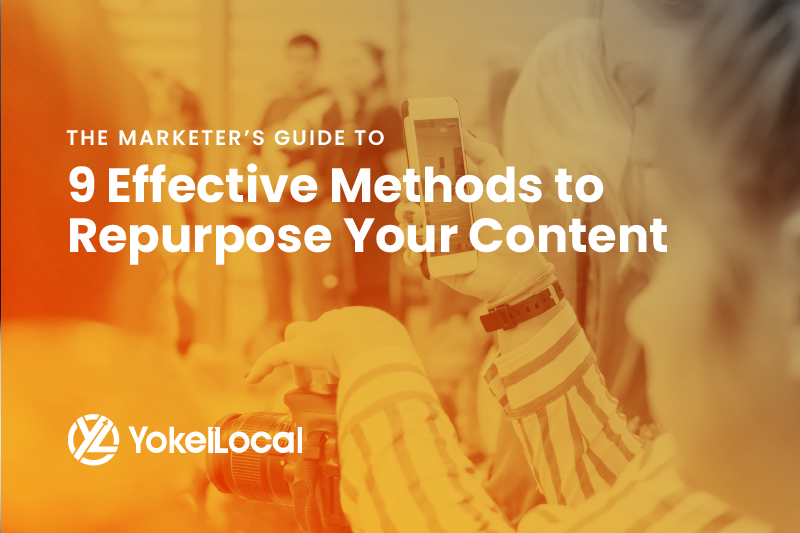You created content that did exceptionally well, and you shared it on your appropriate social media platforms. Are you done with it?
Why Should You Repurpose Content?
You’ve already written, recorded, or designed great content. The next step is to develop new methods to share it. Repurposing your content saves you time because you already finish the bulk of the work. It also allows your brand to reach your audience on different platforms because your entire audience is not just in one place. There is still an enormous untapped audience out there, ready to gobble up your ideas. Some people prefer to read blog posts, while others prefer video.
Starting From Scratch is Too Hard
It can be challenging to push the envelope when it comes to your production schedule, but by fleshing out the resources you already have, being completely open to outside assistance, and spending more time identifying opportunities with new mediums and subtopics, you'll be able to exponentially increase volume without needlessly going back to the drawing board time and time again.
Finding and Promoting Your Best Performing Content
Creating content is only the first step. You will need to conduct some research to discover which content you have that is the most compelling to your audience. It’s best to work with material that will perform well, then to put effort into topics that won’t get enough traction. Depending on the medium you can do this by looking over your analytics to gauge metrics like page views, engagement, and click-through rates. You want only to choose the content you believe can be utilized into different mediums like video, podcasts, presentations, and social posts.
1. Turn Blog Posts Into Video
In today’s marketing world if you’re not producing video content, you’ve fallen behind. Video marketing is dominating on social platforms and the primary way many people want to interact online. But don’t fret creating video content has become more accessible than ever. Especially, when you already own and have the material prepared.
You don’t need any fancy video equipment or editing software. As long as you have a device that can record like a phone or a webcam you can make videos. Let’s say you don’t want to be in the video you can use screen capture software and record a PowerPoint or keynote that summarizes your content instead.
Once you have your method of producing it’s time to adjust your content for video. You don’t want to be reading your blog post word for word. That would be an uninteresting video, and most blog posts are not written to be read aloud. It’s essential to take key points and summarize your information. You also want to keep your videos short and concise! Videos around 2 minutes tend to get more engagement than longer ones.
Lastly, you want your video content to have a call to action that brings people back to your website or your original blog post. You can accomplish this by adding a short message at the end of your video or information place in the video description.
2. Turn Videos into Blog Posts
For most people writing blog posts are not their cup of tea. Sometimes it’s more comfortable to sit down and record yourself talking about a subject than it is to write about it. But that’s okay because You can take your video content and turn it into a blog post.
You can accomplish this by having your video transcribed. Audio transcription is audio converted into text. Having this done to your videos is very beneficial to you have. Here are just a few examples why:
- Allows search engines to index your video content
- Provides people a method to scan your video context before viewing
- Can be turned into captions so the video can be reviewed without sound
- Allows plugins to grab text to share on social platforms
- It will enable you to take the transcription to use as a blog post
There are many tools and services to have your videos transcribed for free or for little cost. Once you have your video transcribed, go over it to make sure it’s easily readable. Transcribing services are not perfect, so spend some time to adjust if needed. But once you have it, you can share it on your blog.
3. Turn Videos into Short Clips or Gifs
So you have a great video you want to share on your social platforms. You make a great post that links to your video, and that’s it. Well if you cut your video down into shorter clips, you will have more content to share!
You can turn your 5-minute video into multiple short gifs that you can share as separate social posts. Providing you with more content to share and keeping your social platforms more active.
Related: 3 Tips to Creating a Successful Social Media Marketing Strategy
4. Turn Blog Posts into eBooks
Do you have a series of blog posts that relate to one another? Then combine them into an eBook. Because why spend more time and resources rewriting what you already have? Take your blog posts and compile them together to produce a product for your audiences. It does take a little amount of time to make your blog posts flow together, but once you’re finished, you have one great piece of content at your disposal.
5. Turn your Statistics and Quotes into Graphics
Does your content contain important statistics or have a brilliant quote? Take it and put in on a graphic and share that graphic across all of your social media platforms.
Social media is about being sociable; your fans want to see content that is inspirational, educational, positive, relatable, and entertaining. Regularly sharing blog posts is not going to warrant much engagement. Taking the most exciting information and putting it into a visual format will make your social posts more desirable.
The best part is that you don't need to be a graphic designer to make simple graphics for social media. There are free and easy tools like Canva and Adobe Express.
6. Turn Your Powerpoints, Keynotes, or Blog Posts into a LinkedIn Slideshare
Have a collection of powerpoints from past presentations? Share and upload them online to Linkedin Slideshare. You can also take information from your blog posts and turn them into visual slides. These presentations are a great way to turn your content into something visual and easy to comprehend.
7. Blog Posts into Infographics
Does your blog post contain a lot of data? Consider turning it into an infographic. Infographics are a great way to take lengthy information and making it visually easier to understand. There are tools for non-designers to utilize and create them with ease. (visually & piktochart) The best part it will look like brand new information.
8. Create Curated Posts
Designate a day of the week to launch a post that aggregates the must-reads for that week. Consider an "industry highlights" section that links to external sources and breaking news for the industry. Also, include a "here's what you missed" section that has top posts for the week.
The only additional content you'll need is a quick summary of what each article is about. Your audience will love the recap, and you'll start to build authority as a trusted source for news.
9. Try the "Solar System" Method
If you're having a hard time just coming up with ideas for posts, it's helpful to go from broad to extremely specific. Choose a larger topic and create a long-form article around it to make your "sun." Then, look at the subheadings to identify additional opportunities for shorter (but more specific) posts that act as planets and other satellites.
Your ideal strategy would then be to link out to those smaller posts within the larger one and promote them separately on social media.
For example: In this post, I've listed out a few tips to solve a potential problem and highlighted why they're useful. In the future, I might want to go back and expand a couple of those tips in new posts, providing more in-depth information and best practices. Not only would linking to these posts prove to be extremely relevant and valuable for a complex site structure, but they'd also open up additional opportunities to connect with a reader.
Related: 8 Powerful Online Marketing Ideas that Will Blow Your Mind
Conclusion
Repurposing content is a great content strategy that helps you fill in the gaps in your editorial schedule. The great thing about it is that you already have the majority of the work done.
For more content marketing strategies, subscribe to #AskYokelLocal













